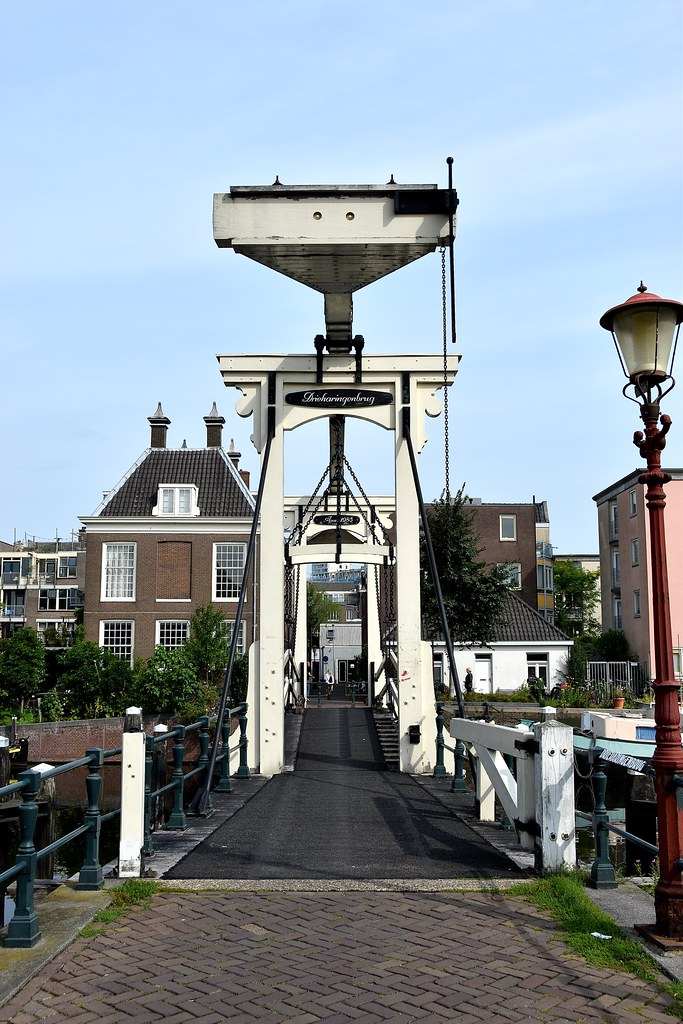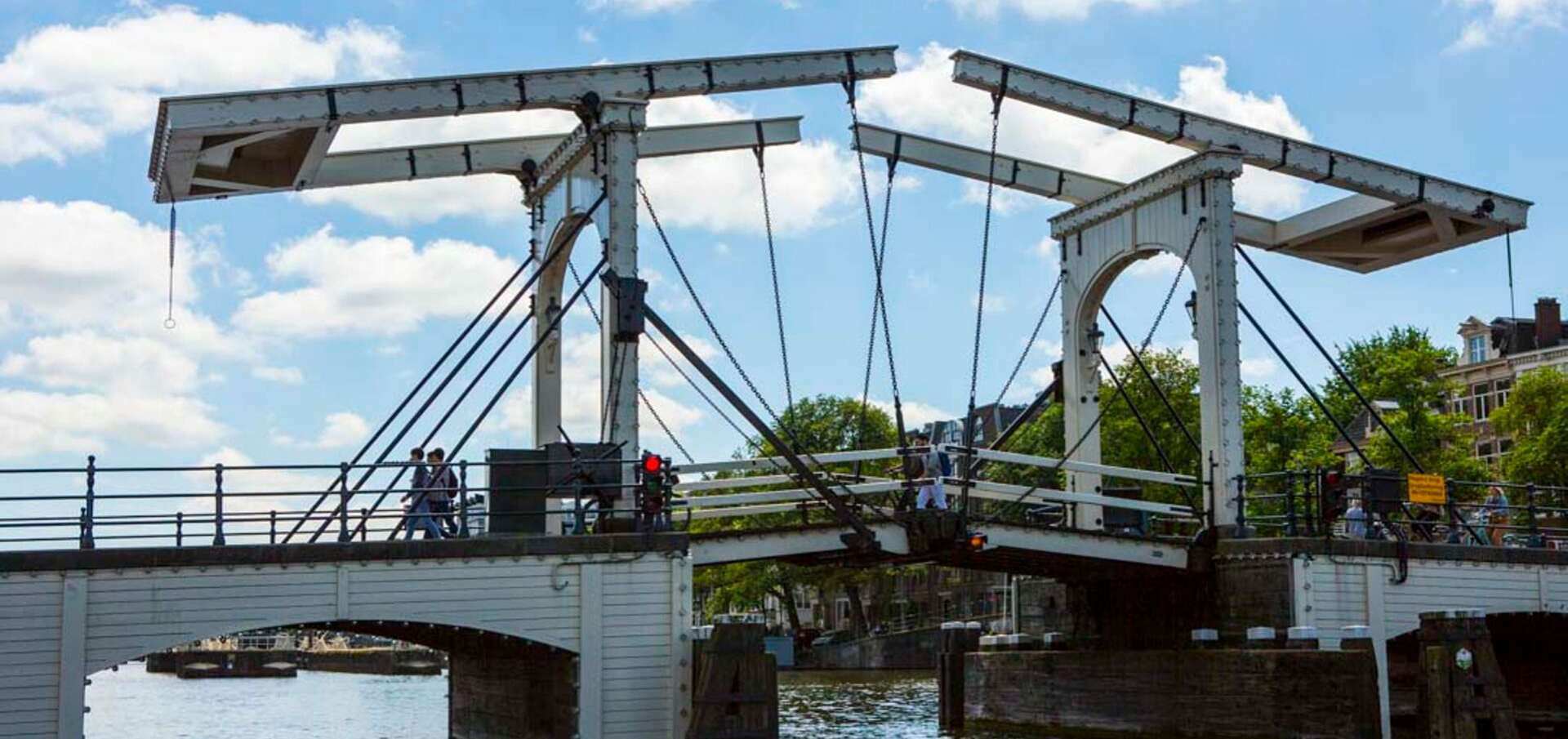Take the reason for the three crosses on Amsterdam’s flag. We’ve got plenty of theories about why they’re there. The drunk at the end of the bar will tell you it’s because of the red-light district (it’s not).
Tour guides will often insist they’re meant to ward off the three disasters the city often faced – fire, flood and the black plague. But it turns out, the use of these types of crosses predates the arrival of the black plague. So, what was that third cross for? Chapped lips? We simply don’t know.
Now, as we’ve spent decades chugging along the city’s canals, we’ve heard our fair share of cool stories ourselves about Amsterdam’s waterways. Here we’d like to share a few with you.

The official skinny bridge isn’t the skinniest
You know that bridge over the Amstel that they call the skinny bridge? Yeah, I’m talking about the one where you tried to take that selfie and then a bike nearly ran into you.
Did you know it isn’t the skinniest bridge in the city? Sure, it was at one time. But a little while ago the traffic over the Amstel river became too much and so they replaced it with something wider. We guess the city’s inhabitants just never really noticed. Hey, but then it was fairly recent by Dutch standard. The bridge was rebuilt in 1871.
I guess it’s a lot like how the bridge they call the ‘blue bridge’ isn’t actually blue.
The actual skinniest bridge is called the Drieharingenbrug or Three Eels Bridge. Perhaps they call it that because three eels couldn’t cross it at the same time? Whatever the case, if you want to talk about skinny bridges, then talk about this one! It’s little more than a raise-able plank with guardrails!
It’s also an incredibly beautiful. In many ways we prefer it to the one in the guide books. Want to go check it out? Here’s the Google Map link!
Amsterdam has far more bridges than Venice
They call Amsterdam the Venice of the North. In our opinion, that’s a disservice to Amsterdam. For one thing, as most seven-year-olds with a map can figure out, Amsterdam isn’t actually in the North. For another, Amsterdam has far more bridges than Venice does.
It does? Yes, it does! Venice boasts about 400. Amsterdam, in the meantime, has a whopping 1824! We know this because each bridge is numbered. You can go find out for yourself if you like. The numbers are written in the bridge’s base.
Whether Amsterdam has the most bridges in the world is a topic of some debate. Hamburg has a lot of bridges as well. How many there are isn’t exactly clear, though. Different sites say different things, though all maintain it’s over 2000. Maybe they should take up the practice of numbering their bridges as well. Anyway, however many they have, maybe we should start calling them the Venice of the North!
Or perhaps it’s time to start calling Venice the Amsterdam (or, fine, Hamburg) of the South.
Big boats can still move through Amsterdam’s small canals
If you’ve taken a tour on the Dutch canals then you’ve probably noticed how darned low those bridges are. That’s why the Dutch tour boats are so darned low lying. Of course, that does bring with it a few problems. One of them is that container ships (not to mention the sailing variety) struggle to move through the city.
Of course, the Dutch have a solution to that (Hurrah for the Dutch!). The municipality has created two routes through the city. Of course, as opening the bridges when there is a lot of traffic can cause all sorts of congestion, these routes are mainly used at night.
So, if you’ve been out on a bender and seen lots of ship’s masts suddenly float by in the middle of the night, you’ll be happy to know it wasn’t the mushrooms.
The oldest bridge in the city used to be a lot more
The oldest bridge in the city is the Torensluis or Tower Lock and is located on the Singel. The ‘lock’ in there refers to a ‘water lock’ but could have just as easily meant ‘mechanical lock’, as in the past it was actually a prison as well!
If you lean over the side, you’ll still see the entrances. These lead to a bunch of cells where prisoners were kept. These were about the worst prison cells the city had to offer, as every high tide they would flood! Could you imagine what that would be like in the middle of winter?
The ‘tower’ part of the name referred to the watch tower which was originally there to keep an eye out for attackers and pirates (arrrrrr, me matey!). That’s also why the bridge is so wide. Otherwise the tower would have blocked the way.
There is a bridge that got into a fight with a building (and they both won)
Despite what you may think, Amsterdam has not stopped building bridges. What has changed a bit, of course, is how they built them. The best example of that is the Jan Schaeferbrug (No that doesn’t translate into something cool. Jan Schaefer is the name of a Dutch politician). This bridge might not be typically 17th century Amsterdam, but it’s still a pretty cool bridge. Why? Because it goes through a building, that’s why!
The building in question is the Pakhuis de Zwijger. Though it wasn’t as old as some of the structures in Amsterdam, it is considered unique through its embrasure of the building style of the 1930s. That’s why there was an uproar when they wanted to knock it down to make way for the bridge. This pushed the architect to come up with a new solution. Now, the bridge goes through the building instead.
Soon after, the building was remodeled and now, instead of being used as a warehouse, has become a cultural center instead. So, you could say, they both won! I guess you could say that’s the polder model in action.

Want more tips? Download our ten top tips on what to do in Amsterdam!
Share this post

Jelte ten Holt
I am a writer, thinker, dreamer and traveler who’d rather collect ideas and memories than couches and clothes. I’d rather share what I have than covet what I don’t.


